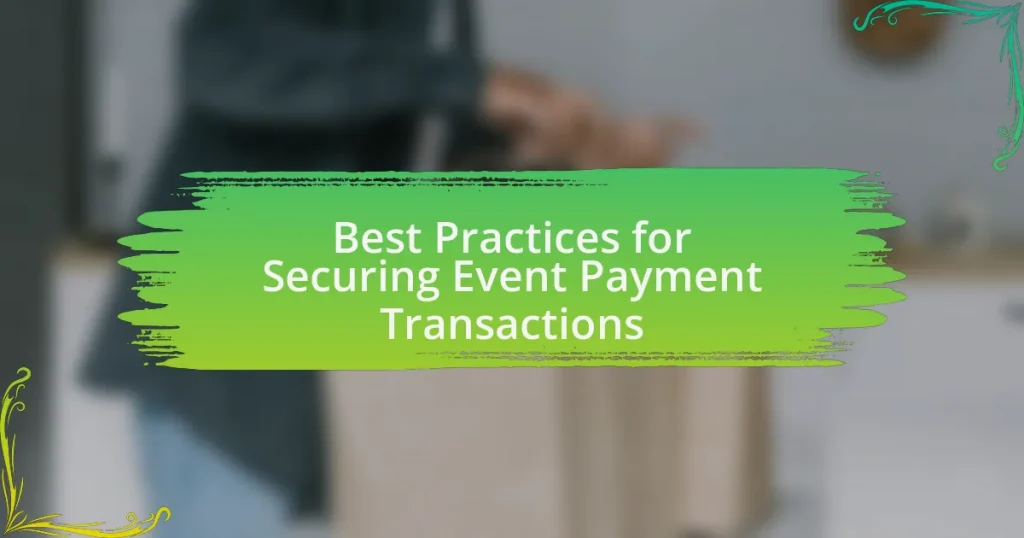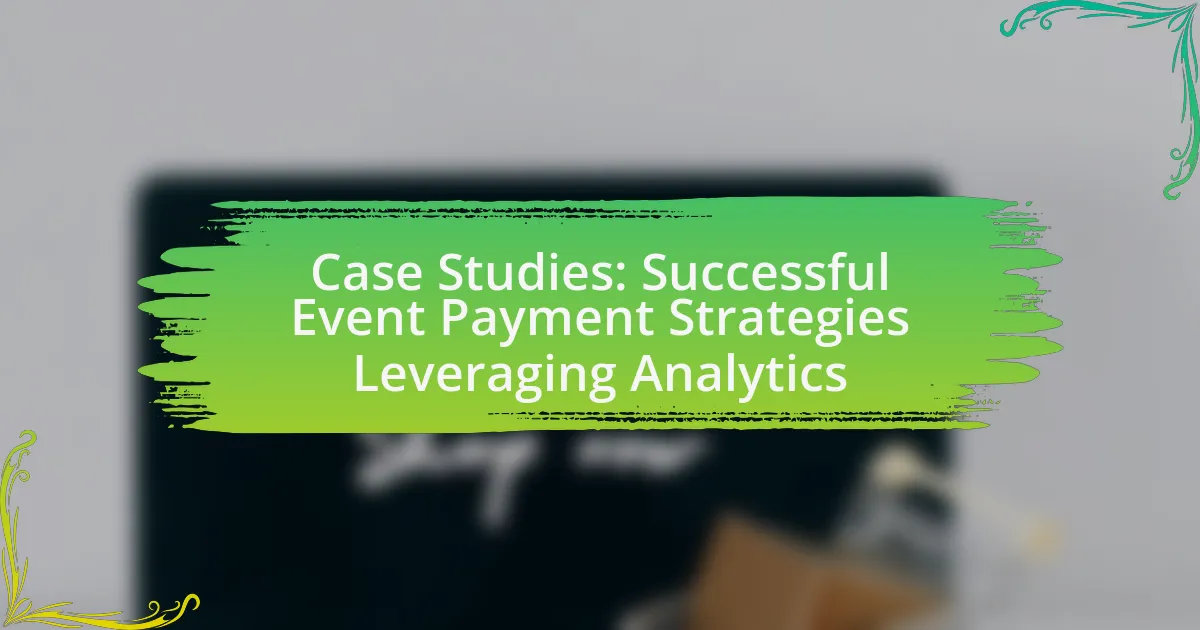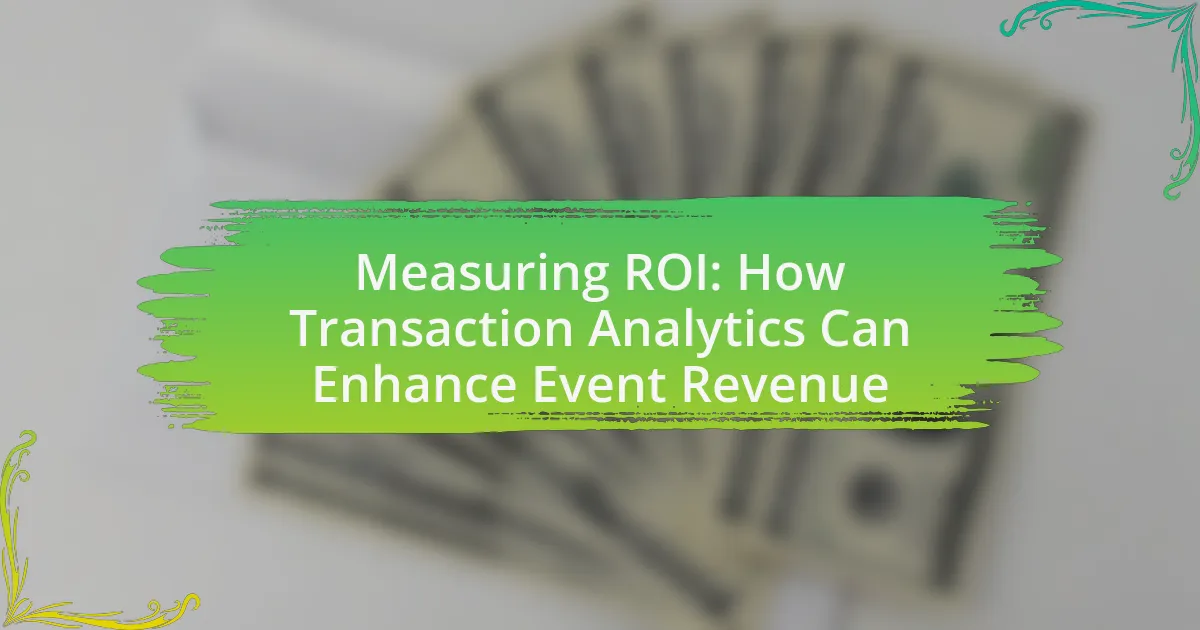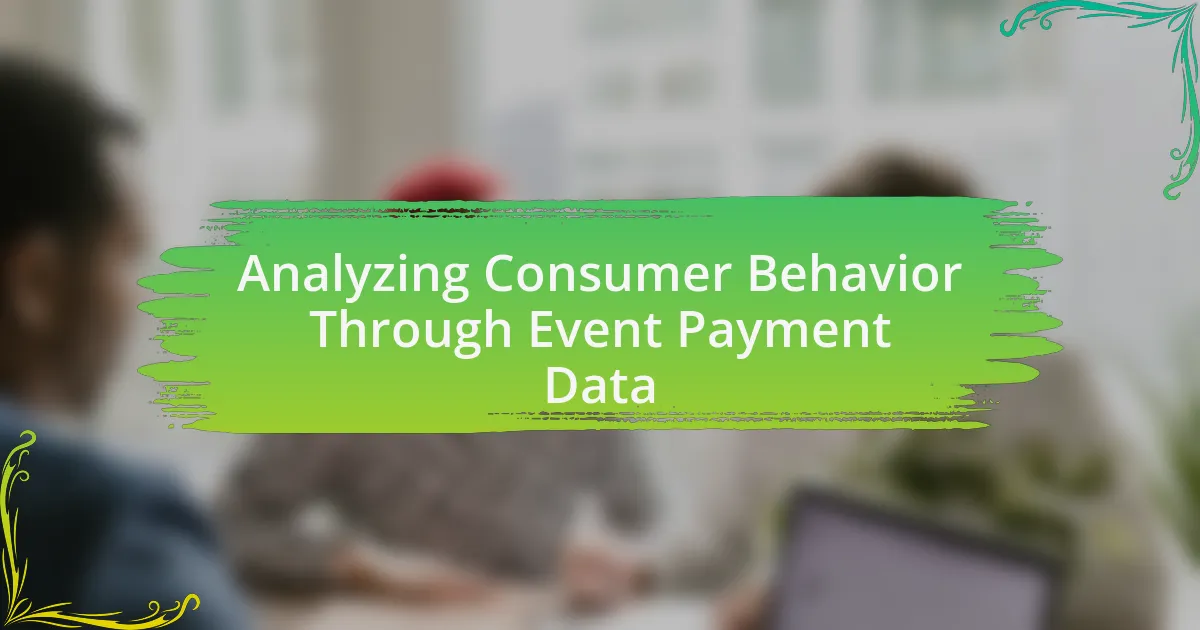The article focuses on best practices for securing event payment transactions, emphasizing the importance of protecting sensitive financial information to maintain customer trust. Key practices include utilizing secure payment gateways, implementing SSL encryption, and ensuring compliance with PCI standards to mitigate risks such as fraud and data breaches. The article also discusses the implications of inadequate security measures, the significance of regulatory compliance, and the essential technologies and strategies for effective payment security. Additionally, it highlights the role of staff training and continuous monitoring in enhancing security protocols for event organizers.
What are the Best Practices for Securing Event Payment Transactions?
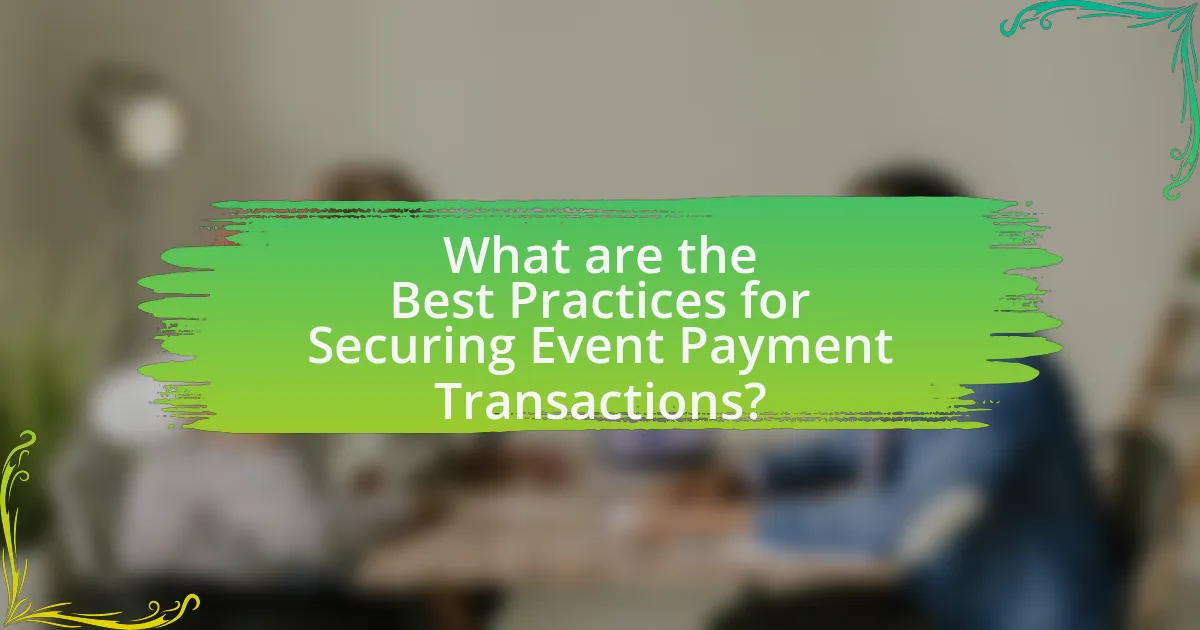
The best practices for securing event payment transactions include using secure payment gateways, implementing SSL encryption, and ensuring PCI compliance. Secure payment gateways protect sensitive financial information during transactions, while SSL encryption safeguards data transmission between the user and the server. PCI compliance is essential for organizations handling credit card information, as it establishes security standards to protect cardholder data. According to the Payment Card Industry Security Standards Council, adherence to these standards significantly reduces the risk of data breaches and fraud.
Why is securing event payment transactions important?
Securing event payment transactions is crucial to protect sensitive financial information and maintain customer trust. When payment transactions are secured, it reduces the risk of data breaches, fraud, and identity theft, which can lead to significant financial losses for both event organizers and attendees. According to a report by Cybersecurity Ventures, cybercrime is projected to cost the world $10.5 trillion annually by 2025, highlighting the importance of robust security measures. Additionally, the Payment Card Industry Data Security Standard (PCI DSS) outlines essential security requirements that help safeguard payment data, further emphasizing the necessity of securing transactions in the event industry.
What risks are associated with unsecured payment transactions?
Unsecured payment transactions pose significant risks, including fraud, data breaches, and financial loss. Fraudsters can exploit vulnerabilities in unsecured systems to steal sensitive information such as credit card numbers and personal identification details. According to a report by the Identity Theft Resource Center, data breaches in 2020 exposed over 37 million records, highlighting the prevalence of such risks. Additionally, unsecured transactions can lead to chargebacks and reputational damage for businesses, as customers may lose trust in a company that fails to protect their financial information.
How can data breaches impact event organizers?
Data breaches can severely impact event organizers by compromising sensitive attendee information, leading to financial losses and reputational damage. When personal data, such as credit card details or contact information, is exposed, organizers may face legal liabilities and regulatory fines, as seen in cases like the 2017 Equifax breach, which resulted in over $700 million in settlements. Additionally, the loss of trust from attendees can decrease future ticket sales and sponsorship opportunities, as consumers are increasingly concerned about data security. Thus, the ramifications of data breaches extend beyond immediate financial costs, affecting long-term business viability and stakeholder relationships.
What are the key components of secure payment processing?
The key components of secure payment processing include encryption, tokenization, secure payment gateways, compliance with standards such as PCI DSS, and fraud detection mechanisms. Encryption protects sensitive data during transmission, ensuring that information like credit card numbers is unreadable to unauthorized parties. Tokenization replaces sensitive data with unique identifiers, reducing the risk of data breaches. Secure payment gateways facilitate the transaction process while safeguarding customer information. Compliance with PCI DSS (Payment Card Industry Data Security Standard) mandates strict security measures for handling cardholder data. Lastly, fraud detection mechanisms utilize algorithms and machine learning to identify and prevent fraudulent transactions in real-time. These components collectively enhance the security of payment processing systems.
What technologies are essential for secure transactions?
Essential technologies for secure transactions include encryption, secure socket layer (SSL) certificates, tokenization, and multi-factor authentication (MFA). Encryption protects sensitive data by converting it into a secure format that can only be read by authorized parties. SSL certificates establish a secure connection between a web server and a browser, ensuring that data transmitted remains private and integral. Tokenization replaces sensitive information with unique identifiers or tokens, minimizing the risk of data breaches. MFA adds an extra layer of security by requiring users to provide two or more verification factors to gain access, significantly reducing the likelihood of unauthorized access. These technologies collectively enhance the security of payment transactions, safeguarding against fraud and data theft.
How do encryption and tokenization enhance security?
Encryption and tokenization enhance security by protecting sensitive data from unauthorized access and reducing the risk of data breaches. Encryption transforms data into an unreadable format, ensuring that only authorized parties with the decryption key can access the original information. For instance, the Advanced Encryption Standard (AES) is widely used to secure payment information during transactions, making it nearly impossible for attackers to decipher without the key. Tokenization, on the other hand, replaces sensitive data with unique identifiers or tokens that have no exploitable value. This means that even if a data breach occurs, the stolen tokens cannot be used to access the original data. According to a report by the Ponemon Institute, organizations that implement tokenization can reduce the cost of a data breach by an average of $1.5 million, demonstrating its effectiveness in enhancing security.
What regulatory standards should be followed for payment security?
The regulatory standards that should be followed for payment security include the Payment Card Industry Data Security Standard (PCI DSS), the General Data Protection Regulation (GDPR), and the Electronic Fund Transfer Act (EFTA). PCI DSS outlines security measures for organizations that handle credit card information, requiring compliance to protect cardholder data. GDPR mandates data protection and privacy for individuals within the European Union, emphasizing the secure handling of personal data. EFTA governs electronic payments and provides consumer protections against unauthorized transactions. Compliance with these standards is essential for ensuring the security of payment transactions and protecting sensitive information.
What is PCI DSS and why is it important?
PCI DSS, or Payment Card Industry Data Security Standard, is a set of security standards designed to ensure that all companies that accept, process, store, or transmit credit card information maintain a secure environment. It is important because it helps protect sensitive cardholder data from theft and fraud, thereby reducing the risk of data breaches that can lead to significant financial losses and damage to a company’s reputation. Compliance with PCI DSS is mandatory for organizations that handle credit card transactions, and failure to comply can result in hefty fines and increased liability in the event of a data breach.
How can compliance with regulations protect event organizers?
Compliance with regulations protects event organizers by minimizing legal risks and enhancing credibility. Adhering to financial regulations, such as the Payment Card Industry Data Security Standard (PCI DSS), ensures that payment transactions are secure, reducing the likelihood of data breaches that can lead to financial losses and reputational damage. Furthermore, compliance with local laws, such as licensing and safety regulations, helps avoid penalties and legal actions that could disrupt events. For instance, a study by the National Association of Professional Event Organizers found that organizations that prioritize regulatory compliance experience 30% fewer legal issues compared to those that do not. This demonstrates that compliance not only safeguards financial transactions but also fosters trust among attendees and stakeholders.
How can event organizers implement security measures effectively?
Event organizers can implement security measures effectively by conducting thorough risk assessments and employing multiple layers of security protocols. A comprehensive risk assessment identifies potential vulnerabilities specific to the event, allowing organizers to tailor security measures accordingly. For instance, utilizing encryption for payment transactions protects sensitive data, while employing trained security personnel ensures physical safety at the venue. According to a report by the International Association of Venue Managers, events that implement a multi-faceted security approach reduce incidents of fraud and enhance attendee safety significantly.
What steps should be taken to choose a secure payment processor?
To choose a secure payment processor, evaluate the processor’s compliance with industry standards such as PCI DSS (Payment Card Industry Data Security Standard). This compliance ensures that the processor adheres to strict security measures for handling cardholder data. Additionally, assess the processor’s encryption methods, as strong encryption protects sensitive information during transactions.
Review the processor’s fraud detection and prevention tools, which are essential for identifying and mitigating potential threats. Furthermore, consider the processor’s reputation and customer reviews, as a solid track record indicates reliability and trustworthiness. Lastly, ensure that the payment processor offers robust customer support, which is crucial for resolving any security issues that may arise.
How can staff training improve payment security?
Staff training can significantly improve payment security by equipping employees with the knowledge and skills necessary to recognize and respond to potential threats. Trained staff are more likely to identify phishing attempts, fraudulent transactions, and security vulnerabilities, which reduces the risk of data breaches. According to a study by the Ponemon Institute, organizations that invest in security awareness training can reduce the likelihood of a data breach by up to 70%. This highlights the effectiveness of training in fostering a security-conscious culture among employees, ultimately leading to enhanced protection of payment information.
What common mistakes should be avoided in payment security?
Common mistakes to avoid in payment security include using weak passwords, neglecting software updates, and failing to implement encryption. Weak passwords can be easily compromised, leading to unauthorized access to payment systems. Neglecting software updates leaves systems vulnerable to known exploits, as outdated software may not have the latest security patches. Additionally, failing to implement encryption can expose sensitive payment information during transmission, increasing the risk of data breaches. According to the Verizon 2021 Data Breach Investigations Report, 81% of hacking-related breaches leveraged stolen or weak passwords, highlighting the critical need for strong password policies in payment security.
How can inadequate security measures lead to fraud?
Inadequate security measures can lead to fraud by creating vulnerabilities that malicious actors exploit to gain unauthorized access to sensitive information. For instance, weak encryption protocols can allow hackers to intercept payment data during transactions, resulting in financial theft. According to a report by the Identity Theft Resource Center, in 2021, data breaches exposed over 22 billion records, highlighting the significant risk posed by insufficient security. Additionally, lack of multi-factor authentication can enable fraudsters to easily compromise accounts, as they can bypass single-layer security defenses. Therefore, the absence of robust security protocols directly correlates with increased opportunities for fraudulent activities.
What are the pitfalls of using outdated technology?
Using outdated technology can lead to significant security vulnerabilities, increased operational costs, and reduced efficiency. Specifically, outdated systems often lack the latest security features, making them susceptible to cyberattacks; for instance, a 2021 report by Cybersecurity Ventures estimated that cybercrime damages would reach $6 trillion annually, largely due to outdated defenses. Additionally, maintaining legacy systems can incur higher costs due to the need for specialized support and the inefficiencies that arise from using slower, less capable technology. Furthermore, outdated technology can hinder compliance with current regulations, exposing organizations to legal risks and potential fines.
What are the best practices for monitoring and responding to security threats?
The best practices for monitoring and responding to security threats include implementing continuous monitoring systems, establishing an incident response plan, and conducting regular security assessments. Continuous monitoring systems utilize automated tools to detect anomalies and potential threats in real-time, allowing for immediate action. An incident response plan outlines the steps to take when a security breach occurs, ensuring a swift and organized response. Regular security assessments, including vulnerability scans and penetration testing, help identify weaknesses in the system before they can be exploited. These practices are supported by industry standards such as the NIST Cybersecurity Framework, which emphasizes the importance of proactive threat detection and response strategies.
How can real-time monitoring help in identifying threats?
Real-time monitoring enhances threat identification by providing immediate visibility into transaction activities and anomalies. This continuous oversight allows security systems to detect unusual patterns, such as sudden spikes in transaction volume or atypical payment methods, which may indicate fraudulent behavior. For instance, a study by the Association for Financial Professionals found that organizations employing real-time monitoring reported a 30% reduction in fraud incidents. By analyzing data as it occurs, businesses can respond swiftly to potential threats, minimizing financial losses and protecting customer information.
What should be included in an incident response plan?
An incident response plan should include the following key components: preparation, identification, containment, eradication, recovery, and lessons learned. Preparation involves establishing and training an incident response team, while identification focuses on detecting and reporting incidents. Containment strategies aim to limit the impact of an incident, and eradication involves removing the cause of the incident. Recovery outlines the steps to restore systems and operations, and lessons learned emphasize reviewing the incident to improve future responses. These components are essential for effectively managing security incidents, as outlined by the National Institute of Standards and Technology (NIST) in their Special Publication 800-61, which provides a comprehensive framework for incident handling.
What practical tips can enhance the security of event payment transactions?
To enhance the security of event payment transactions, implement strong encryption protocols such as SSL/TLS to protect sensitive data during transmission. This ensures that payment information is securely transmitted between the user and the payment processor, reducing the risk of interception by malicious actors. Additionally, utilize secure payment gateways that comply with PCI DSS (Payment Card Industry Data Security Standard), which mandates strict security measures for handling card information. Regularly update software and payment systems to patch vulnerabilities, as outdated systems are more susceptible to attacks. Employ multi-factor authentication for users to add an extra layer of security, making unauthorized access more difficult. Finally, educate staff and users about phishing scams and safe online practices to minimize human error, which is often a significant factor in security breaches.
